Early History of the Telescope
Jack Kramer
Part I: In the Beginning... In the popular mind, many people believe Galileo invented the telescope. He didn't ... he simply knew how to take advantage of a good thing. I was curious about the early history of the telescope and discovered that there were more players involved than just the few most of us have heard about. I had written an article on the subject back in 1997, so it seemed appropriate to expand that article to reflect newly acquired info.
The magnifying properties of convex and concave transparent objects was known in antiquity. But just when the very first magnifying device was made is a matter of conjecture. In 1850, archeologist John Layard discovered what looks like a lens at the site of the palace of Nimrud in what is now Iraq. So if the first actual lens dates to the ancient Assyrians, that would make lenses about 3000 years older than had been thought. According to Professor Giovanni Pettinato of the University of Rome, this rock crystal "lens" could explain why the ancient Assyrians knew so much about astronomy. Others disagree, arguing that this crystal is far too opaque to function as a useful lens.
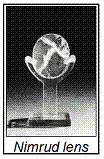 We do know that by the thirteenth century magnifying glasses were being made. A record of spectacles that could be placed over the eyes first appears around 1350, and since the glass pieces were shaped like lentils (a split pea-like vegetable), they became known as "lentils of glass", or from the Latin word for lentil ... "lens". The telescope was probably invented in 1570 by Thomas Digges in England, but it was only a laboratory experiment. It's known that three different individuals (two in Holland and one in Germany) were the first to attempt to popularize telescopes. The spectacle maker Jan Lippershey gets the credit for inventing the telescope because it is recorded that he was the first to seek a patent for a spyglass in October 1608. But the patent was denied because it was considered too easy to copy and because two other Dutch spectacle makers, Jacob Adriaanzoon and Zacharias Jansen, also claimed to have invented "an instrument for seeing at a distance". The first widespread use was by the Dutch for spying on foreign ships. The following is the earliest known illustration of a telescope, by Giovanpattista della Porta in August 1609.
We do know that by the thirteenth century magnifying glasses were being made. A record of spectacles that could be placed over the eyes first appears around 1350, and since the glass pieces were shaped like lentils (a split pea-like vegetable), they became known as "lentils of glass", or from the Latin word for lentil ... "lens". The telescope was probably invented in 1570 by Thomas Digges in England, but it was only a laboratory experiment. It's known that three different individuals (two in Holland and one in Germany) were the first to attempt to popularize telescopes. The spectacle maker Jan Lippershey gets the credit for inventing the telescope because it is recorded that he was the first to seek a patent for a spyglass in October 1608. But the patent was denied because it was considered too easy to copy and because two other Dutch spectacle makers, Jacob Adriaanzoon and Zacharias Jansen, also claimed to have invented "an instrument for seeing at a distance". The first widespread use was by the Dutch for spying on foreign ships. The following is the earliest known illustration of a telescope, by Giovanpattista della Porta in August 1609.

A Revolution for Astronomy Interest in this invention spread quickly and by 1609 a number of three power spyglasses had been imported to Italy and France. Glass making was highly advanced in Venice and Florence, so it was natural that spyglasses began to be made there. Galileo was keenly interested in this device and began to grind lenses for his own instruments. It was one of his patrons who coined the word "telescope". When he conducted his observations in the early 1600's, Galileo primarily used two telescopes; each had a double-convex lens in front, and an eyepiece that was a single double-concave lens. One had an objective of 26mm with a focal ratio of f/51, giving 14 power, and the other had a 16mm objective at f/61, which gave 21 power.
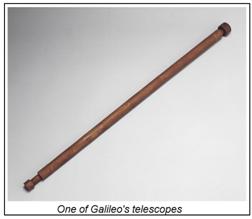 Those familiar with optics will realize that these designs provided ridiculously narrow fields of view by today's standards. Modern day analysis of his lenses shows they had a surprisingly good figure; however, there were a lot of bubbles and other impurities in the glass, plus they had a slightly greenish tinge. As a result, images were never really sharp. This explains why Galileo did not understand the nature of Saturn; to him it appeared simply as a curious oblong blob. Eventually, he saw it as a center disk with what appeared to be two smaller disks, one on each side.
Those familiar with optics will realize that these designs provided ridiculously narrow fields of view by today's standards. Modern day analysis of his lenses shows they had a surprisingly good figure; however, there were a lot of bubbles and other impurities in the glass, plus they had a slightly greenish tinge. As a result, images were never really sharp. This explains why Galileo did not understand the nature of Saturn; to him it appeared simply as a curious oblong blob. Eventually, he saw it as a center disk with what appeared to be two smaller disks, one on each side.
Galileo had begun his observations with a 3x spyglass in June or July of 1609. Thomas Harriot began observation of the moon in August 1609 using a 6x spyglass. What sets Galileo apart from the other observers is that he devoted himself to making new and more powerful telescopes and turned his attention to other objects in the night sky. Not only did he observe the moon, but he discovered the satellites of Jupiter and resolved hazy spots into stars. In March 1610 he published his seminal work Sidereus Nuncius. It took awhile for Galileo's discoveries to be confirmed by others because there simply weren't any telescopes capable of equaling his feat. However, more observers began to catch up and in early 1611 a number of others were able to verify the phases of Venus. And Galileo was only one of several observers who discovered sunspots.
In 1611 Johannes Kepler redesigned the eyepiece to make it convex, rather than concave, thus widening the field of view, but also inverting the image. This new design was not embraced by astronomers until 1630 when Christoph Scheiner pointed out that a convex eyepiece also presents a brighter image and he noted that adding a second convex element to the eyepiece would make the image erect and suitable for terrestrial use. So in the second half of the seventeenth century, Galileo's design was replaced for terrestrial purposes by a telescope with at least three convex lenses: an objective, ocular, and erector lens. But by this time, astronomers had found that due to the current quality of the glass, addition of an erecting lens simply multiplied the optical defects. They also realized that an inverted image was perfectly acceptable for their purposes, so they adopted Kepler's simpler design. Thus was born what we now refer to as the "astronomical telescope".
By the 1640s telescope makers were hard at work trying to increase magnification. But due to the low quality of optical glass and the difficulty of generating a deep curve on a lens, the only way they could do this was to go to ever-longer focal lengths. In 1656 Christiaan Huygens made a telescope that was 23 feet long. It had an aperture of several inches and magnified about 100 times, with a field of view of only 17 arc-minutes. Huygens also invented the first achromatic eyepiece - the Huygenian - which was still being used in recent times. Being both an astronomer and mathematician, Huygens was one of the first to apply mathematical principles to the design of optics. Up to this time, all advances basically resulted from trial and error. It was Huygens who first established the nature of Saturn's ring system. Apparently, telescopes by this time were able to resolve to nearly one arc-second because the division in Saturn's ring-system was first recorded in 1675, and five of its moons were discovered between 1655 and 1684.
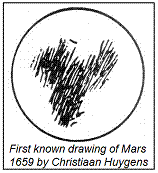 But further increases would restrict the field of view so much that the telescope would be worthless. At this point it was found that a field lens placed at the right point would widen the field of view. The only problem was that such long tubes proved ungainly as even the slightest wind caused them to shake uncontrollably. So after about 1675, astronomers adopted a new design that entirely did away with the telescope tube. Called "aerial telescopes", the objective was mounted on a building or pole by means of a ball-joint and aimed by means of a string. The image was found by trial and error, and an eyepiece mounted on a stand was then positioned to receive the image from the objective. We can only imagine the difficulty encountered in observing with such a setup!
But further increases would restrict the field of view so much that the telescope would be worthless. At this point it was found that a field lens placed at the right point would widen the field of view. The only problem was that such long tubes proved ungainly as even the slightest wind caused them to shake uncontrollably. So after about 1675, astronomers adopted a new design that entirely did away with the telescope tube. Called "aerial telescopes", the objective was mounted on a building or pole by means of a ball-joint and aimed by means of a string. The image was found by trial and error, and an eyepiece mounted on a stand was then positioned to receive the image from the objective. We can only imagine the difficulty encountered in observing with such a setup!
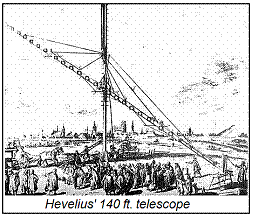 Despite improvements in the quality of optical glass, there was still the problem of chromatic aberration -- the colored glow around bright objects. Our eyes are most sensitive in the yellow part of the spectrum at almost the exact frequency that the Sun radiates most strongly. A simple lens can sharply focus a maximum of two colors at a time. Therefore, we tend to focus on the colors yellow and green. Colors on the opposite ends of the spectrum -- red and blue-violet -- are out of focus, so objects have a purple halo. In addition to increasing magnification, a longer focal length tended to minimize this chromatic aberration.
Despite improvements in the quality of optical glass, there was still the problem of chromatic aberration -- the colored glow around bright objects. Our eyes are most sensitive in the yellow part of the spectrum at almost the exact frequency that the Sun radiates most strongly. A simple lens can sharply focus a maximum of two colors at a time. Therefore, we tend to focus on the colors yellow and green. Colors on the opposite ends of the spectrum -- red and blue-violet -- are out of focus, so objects have a purple halo. In addition to increasing magnification, a longer focal length tended to minimize this chromatic aberration.
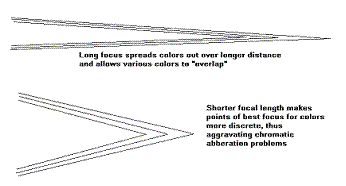 Published in the October 2008 issue of the NightTimes
Published in the October 2008 issue of the NightTimes





